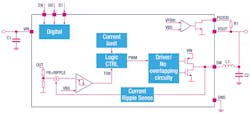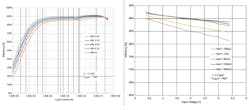As the Internet of Things (IoT) and other applications increasingly embody functions with ultra-low duty cycles (think temperature sensing) while operating from severely limited energy sources (harvesting or 10-year batteries), low quiescent current is becoming a specification as important as actual operating current.
The ST1PS01 step-down (buck) dc-dc converter developed by STMicroelectronics (Fig. 1) features requisite small size and high efficiency, of course. It’s noteworthy for two other features: a quiescent-current value of 500 nA (typical), and its output voltage can be dynamically set to one of four values between 1.8 and 3.3 V via two digital-control inputs (the specific available four values depend on which ST1PS01 variant is ordered).
1. The STMicroelectronics ST1PS01 delivers up to 400 mA from a 1.14- × 1.41-mm flip-chip package, with quiescent current of just 500 nA and four digitally selectable output voltages that can be switched dynamically.
Key applications include asset tracking, gas/water energy meters, and long-term portable medical monitoring, to cite a few among many others. The IC, complete with integrated power switch, synchronous rectifier, and integrated compensation network, has an input-voltage range between 1.8 and 5.5 V (the 1.8-V minimum supply-input voltage allows use of various battery chemistries including a single lithium-based cell). Maximum delivered output current is 400 mA.
Typical efficiency is 94% at 1 mA load with VIN at 3.6 V and VOUT at 3.3 V (Fig. 2), while output voltage accuracy measures ±2%. When in use, the IC requires just a small inductor, two same-value capacitors, and a resistor (typically 2.2 µH, 10 µF, and 1 MΩ, respectively).
2. Performance of the ST1PS01 is characterized by multiple graphs showing efficiency vs. load for VOUT = 1.8 V (left) and efficiency vs VIN, for VOUT = 1.8 V (right).
Other features include undervoltage lockout (at 1.57 V), embedded soft-start circuit, overcurrent protection, active output-voltage discharge, and an output-voltage power-good flag. Small size is also a feature thanks to its 1.14- × 1.41-mm flip-chip package with 400-μm pitch. Design-in support is provided by the STEVAL-1PS01EJR evaluation board. Available now, the ST1PS01, specified for ambient temperature operation from −40 to +85°C, is priced at $0.686 each (1000-piece lots).



